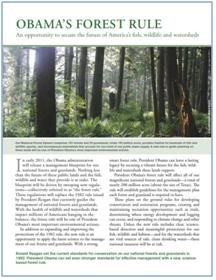Is discussed throughout the Proposed Rule. In case you missed it, here it is :
The USDA Forest Service Mission: “To sustain the health, diversity, and productivity of the Nation’s forests and grasslands to meet the needs of present and future generations.”
The agency mission, one of sustainability, provides the foundation for the Recreation, Heritage, and Volunteer programs.
Our Vision … “Renewing Body and Spirit, Inspiring Passion for the Land”
We provide recreation on treasured lands that brings health and vitality to individuals and communities and showcases our country’s natural abundance. Recreation on the National Forests and Grasslands invokes feelings of connection to the natural world and inspires responsibility to care for it.
Guiding Principles for our mission and vision:
Connecting people with their natural and cultural heritage is a vital thread in the fabric of society. It contributes to the American identity and reminds people of the resources that sustain life – water, soil, food, and fiber. Moreover, recreation is the portal for understanding and caring for natural resources and public lands. It provides opportunities and motivation to advance from fun and attraction, through awareness, education and understanding, to a role of citizen stewardship – one of “giving back” and supporting sustained management of natural resources.
June 25, 2010 Page 4
Recreational activity in the great outdoors promotes healthy lifestyles. Combined with good nutrition, it contributes to improved physical, mental, and spiritual health, and a shift away from treating illness toward creating wellness.
Sustainability underlies all program decisions. In order to sustain the benefits of outdoor recreation for present and future generations, the recreation program must address and work toward a sustainable balance among the three spheres of environmental, social, and economic conditions.
Community engagement is essential for creating a sustainable recreation program. Our role is to serve as planners, facilitators, conveners, and collaborators, tapping the enormous energy and creativity of people in communities that care for and benefit from public lands, including both the private and public sectors.
National Forests and Grasslands are part of a larger landscape that includes: other public lands; open spaces at the local, state, and federal level; tribal lands; working farms and ranches, and; towns and cities. Respecting and cultivating the relationships across all lands and communities is necessary to strengthen the health and vitality of each.
The Recreation program is integrated into the larger agency mission. By working together with other program areas to integrate program goals and service delivery, we maximize our contribution by connecting programs, people, and landscapes. .
Our Goals
Building on the foundation of the Mission, Vision, and Guiding Principles, we will strive to:
Provide a diverse range of quality natural and cultural resource based recreation opportunities in partnership with people and communities.
Protect the natural, cultural, and scenic environment for present and future generations to enjoy.
Partner with public and private recreation benefit providers that together we meet public needs and expectations.
Perform and plan by implementing systems and processes to ensure: effective decisions, sound investments, and accountability; collaborative approaches to integrated solutions across the landscape; and enhanced professionalism of our workforce.






